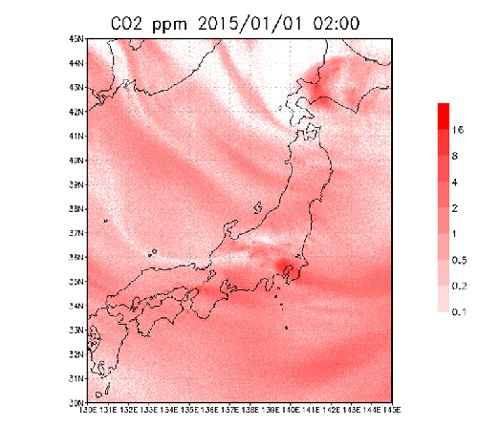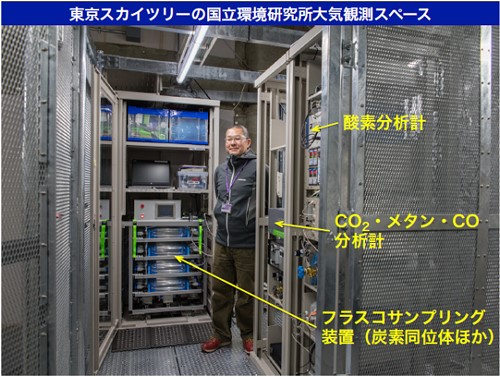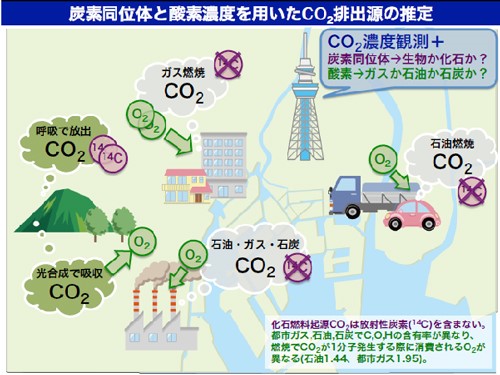News
Monitoring Greenhouse Gases at Tokyo Sky Tree Updated in September 2017
A research group consisting of National Institute for Environmental Studies (NIES) announced that it began observing greenhouse gases (e.g. carbon dioxide) in the atmosphere at Tokyo Sky Tree (Sumida-ku, Tokyo), the tallest landmark in Japan. The laboratory says it will accurately grasp and monitor the current status of greenhouse gas emissions.
The group consists of researchers from NIES, University of Tokyo Atmosphere and Ocean Research Institute (AORI), Meteorological Research Institute (MRI), and National Institute of Advanced Industrial Science and Technology (AIST). In March 2016, NIES installed an atmospheric observation device within Tokyo Sky Tree at 250 meters. In addition to carbon dioxide and methane greenhouse gases, the team also started observing isotope ratios of carbon monoxide and carbon dioxide, plus the amount of oxygen in the atmosphere.
NIES analyzes concentrations of carbon dioxide (CO2), methane (CH4), carbon monoxide (CO), and oxygen (O2) at Sky Tree, and also takes the sampled atmosphere back to the same laboratory to analyze the radiocarbon dating (carbon-14 dating) isotope ratio and other traces. Carbon monoxide does not absorb much infrared radiation from earth's surface. So technically, CO is not a greenhouse gas but it affects the concentration of greenhouse gas.
According to the research group, carbon dioxide is emitted from various parts of the city, but by analyzing the radiocarbon dating isotope ratios, we can see whether the CO2 originated from plants or from burnt fossil fuel. Moreover, by analyzing the oxygen concentration, one can tell if the burnt fuel was natural gas or oil.
Atmospheric observation of greenhouse gas and related substances in large cities has only been conducted in limited places around the world: Paris (France), Indianapolis and Los Angeles (U.S.), Yoyogi (Tokyo, Japan) and so on. In Yoyogi, observation device is installed at Tokai University’s Yoyogi Campus (Shibuya-ku, Tokyo). From November 2012, Japan’s National Defense Academy and AIST started to observe the amount of CO2 exchange between the atmosphere and the earth’s surface. From March 2016,
AIST is observing CO2 and O2 concentrations respectively. From November 16, 2016 onwards, NIES began observing CO2’s radiocarbon dating isotope ratio and from February 2017, NIES also began watching methane/carbon monoxide concentration. Both observations are conducted at Tokai University Yoyogi Campus.
To steadily advance measures against global warming, it is important to conduct atmospheric observation in such metropolitan areas and cooperate with greenhouse gas observation satellites like IBUKI (GOSAT). The observation project at Sky Tree Tokyo will enable monitoring of CO2 emission in its actual state around Tokyo, one of world's largest cities.
Tokyo Sky Tree is a 634 meter-high radio wave tower. Tobu Railway built this landmark at an old freight station site in Sumida-ku, Tokyo. It opened on May 22, 2012. Tobu Tower Sky Tree is its operating company. These days, it is a well-known tourist attraction. Observation decks are located in two places: at 350 meters and at 450 meters. Japan’s national broadcaster NHK and five major private TV stations are using Sky Tree as a radio tower for the Tokyo metropolitan area.

Photos courtesy of Japan Science and Technology Agency









